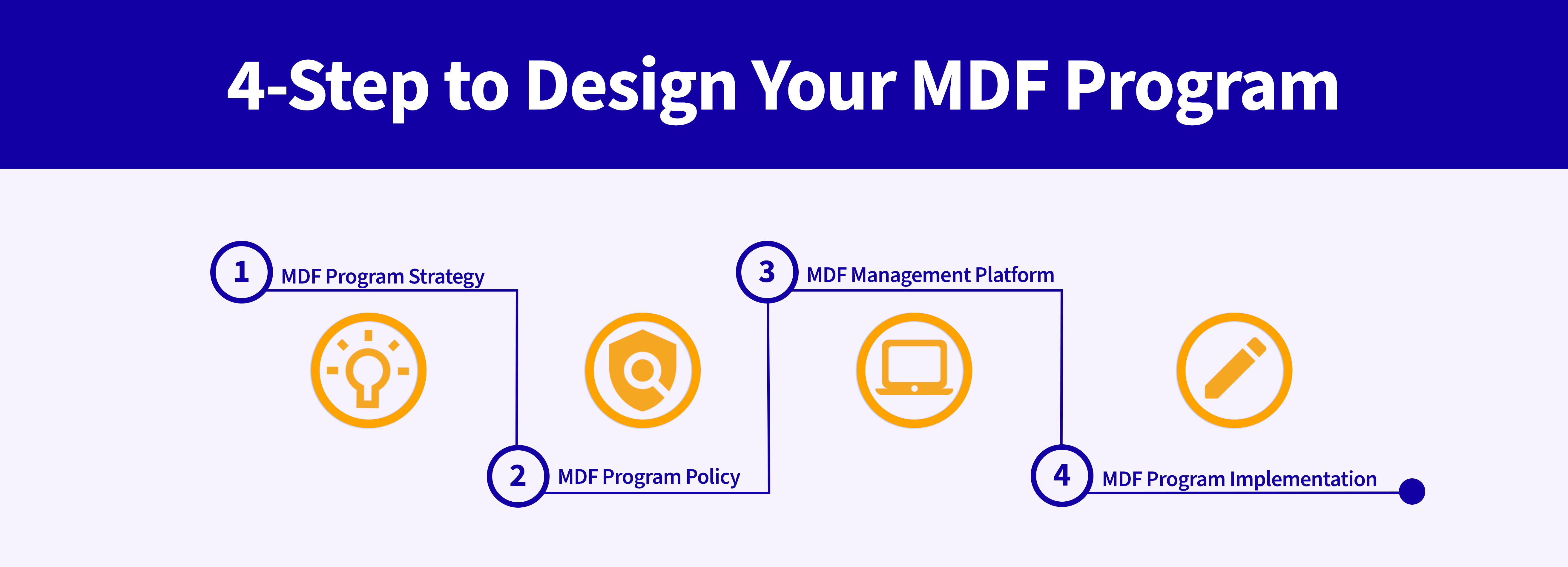
Partner incentives are the key to orchestrating your ecosystem for effective channel management. With a well-executed partner incentives or Market Development Funds program, your company can drive the right partner behaviors and boost your channel sales. However, implementing a partner incentives program isn’t a “one size fits” all proposition.
Your optimal Market Development Funds strategy and implementation depend on your partner and co-selling goals. Maximizing your ecosystem means aligning your partner incentive program with your partnership needs, offerings, and market demand.
Recently we published our Ultimate MDF and Partner Funds Guide where we discuss the 4 steps your company can take to design a partner incentive program. In this blog, we’re going to guide you through each step to help you create your own custom-made partner incentives or market development funds program.

1. Structuring Program Strategy
The first step to designing your Market Development Funds and partner incentive program is mapping out your strategy. Each partner ecosystem is different. Your partners, joint offerings, and customers will ultimately determine the optimal strategy for your partner fund program.
One way to organize this process is to think about which partner behaviors drive the most value for your company and customers? And how can your company incentivize this behavior? For example, if your company co-sells a joint solution on a subscription-based model, your program strategy might be focused on driving renewals and thus emphasize lifecycle funds. On the other hand, if your joint offering needs more exposure, your strategy might be focused on partner marketing and favor Market Development Funds. If you need to brush up on which incentives drive which behaviors, check out our blog on The 8 Partner Incentives You Need to Know to Drive Channel Sales.
To maximize your ecosystem value and accommodate different partner needs may require applying different incentive strategies for different partners and joint offerings. So budgeting and allocating appropriate funds for each program strategy is a crucial part of your channel management and program strategy.
2. Framing Program Policy
To launch a successful partner incentive program, you’ll need to write a clear and well-structured program policy document that aligns with and supports your program strategy. This program policy should be easily accessible to your partners and could be part of the initial communication at launch time.
Your partner fund policy should include guidelines for your partners that explain their expected standards, processes, and behavior when they participate in the program. Aim for as much transparency and clarity in this step to avoid future obstacles. Your partners' compliance with the policy should be considered a precondition for participating in your MDF Program.
3. Picking the Right Management Platform
Effective channel management and implementation of your partner's marketing strategy are extremely difficult. Some have tried managing these programs with spreadsheets, but it’s nearly impossible and can open you and your company up to potentially serious compliance issues. To ensure the success of your program, it’s critical to investigate and implement a platform to automate these processes and manage your partner fund program.
Ecosystem business management platforms like WorkSpan allow partners to seamlessly collaborate, manage requests, approvals, and reimbursement processes, and have clear visibility on fund availability, progress statuses, real-time metrics, and deeper ROI data.
Allowing you and your partners to have a single shared space to collaborate, platforms help your company maximize channel sales and simplify channel management. For these reasons, upgrading to a management platform is the third step to designing a successful partner incentive and MDF program.
4. Program Implementation
The final step in designing an effective partner funds program is where the rubber meets the road - implementing all the hard work you’ve put into designing your program. In this stage, you are working to optimize the partner experience of your program. This process can be divided into seven phases:
- Accept Partner Funds / MDF Program Applications
- Approve/Reject Applications
- Launch Partner Funds / MDF Program Initiatives
- Measure Program Outcomes
- Accept Claim Requests
- Approve Claim Requests
- Pay Out Claimed Funds
1. Accepting Partner Funds / MDF Program Requests
You’ll need to first communicate your partner incentive program to your partners and receive their requests. In this stage, it is important for you to clearly explain your strategy for the program and point partners towards your policy. Ensuring that your partners understand how they’re being rewarded is the key to motivate them to participate. Based on the technology you use, you can accept program applications in three ways:
- Emails
- Application Forms
- Request through a platform
Collect the following details from your channel partners who are requesting partner funding:
- Initiatives and activities to be funded (Webinars, events, email campaigns, sales promotions, POCs, etc.)
- Target audience (Personas, seniority, industries, regions, line of business, etc.)
- The solution to be promoted (Software, hardware, services, etc.)
- Expected goals and ROI from activities (Number of qualified leads, trial downloads, closed revenue, etc.)
- Key dates (Program design, approvals, start dates, end dates, etc.)
- Required details to be eligible for the program (Specific Range of Revenue, certification, etc.
2. Approving Requests
After receiving fund requests from your partners, you will also need to implement a mechanism to review and respond to these applications. When deciding whether to accept or reject a request you should consider whether your partner meets the qualifying criteria and is capable of performing the requested activity. To ensure a healthy pipeline of new requests, your company should respond to partner applications within a stipulated turnaround time, abiding by your program policy. An ecosystem management platform can help you manage this process by requiring and assembling all the needed information, routing to the right places for input and approvals, and getting these partner programs in the market effectively to drive revenue with your partners.
3. Launching Funded Program Activities
After giving your partners the green light, they’ll begin to launch these funded program activities. Your responsibility during this step is to monitor your partners’ actions. Ensure that these activities are aligned with your overall partner strategy, following your program policy, delivering value to the customer, and driving revenue for your company. In addition, your company should ensure that these programs are measurable and you can evaluate partners’ performance and your program’s success. To help your partners effectively execute your funded activities, you may provide partner marketing resources, training, and more.
4. Measuring Funded Program Activity Outcomes
Measuring and evaluating the funded program activities is crucial to the success of your partner incentive program. If you don’t have clear visibility on what actions your partners have taken and how much value they’re driving, it will be impossible to appropriately incentivize your partners.
Use an ecosystem management platform to give you real-time metrics that will help you easily keep track of your partners’ funded activities and measure your program's performance. The data you collect will ultimately inform you of which partners are driving the most value and how your company should move forward with each partnership in the future.
Your program's success depends on performance metrics like the number of potential customers acquired, qualified leads, joint opportunities created, customer PoCs completed, etc. Instead of analyzing your program's performance right after the project is completed, you can also set intermediate milestones for measuring results to make your program more targeted, yielding increased ROI.
5. Accepting Claim Requests
The last three steps are around making sure your partners can be compensated for their actions. Similar to making sure you’re able to receive program requests from partners, your company needs to have an efficient mechanism to receive claim requests. An ecosystem management platform like WorkSpan effectively automates this process for you and gives you clear visibility to any incoming requests.
Your channel partners can propose one or more claims against their approved program requests by creating a claim request of total or partial reimbursement. Depending on the agreement, partners may also need to submit proof of performance (POP) and/or proof of execution (POE). Some vendors require a return on investment proof of performance (ROI POP) when partners make a claim.
6. Approving Claim Requests
Before paying out claimed funds, you need to evaluate each claim request. If your company closely monitors your fund programs and uses a platform that gives you real-time metrics, this process becomes extremely simple. Accurate and timely evaluations of each request are extremely important to not misallocate funds while keeping partners engaged.
Your approval process needs to be clearly defined and could include multiple levels of approval, depending on the reimbursement amount. Approvers should include members who understand the claims process (including SOP, guidelines, acceptable POE/POP/ ROI POP submissions for any MDF program activities). Based on the evaluation, communicate the approval or rejection of fund claim requests to your ecosystem partners in a timely way.
Heads up: This process is critically important and, if not well managed, can lead to compliance and audit issues down the road. You should include your finance and security team in the design and implementation of this step in the process to make sure it’s bulletproof.
7. Paying Out Claimed Funds
Finally, you need to decide how your company will pay out the claimed funds to your partners. Traditionally, there are two modes to payout funds to your channel partners: cash and credit. The selection of either is typically dependent on your industry and/or ecosystem practices. After the payout, ensure that you communicate the payment release to your partners, mentioning the claim ID, amount, and reference ID.
The Bottom Line
In this blog, we hope to have given you a detailed view of how to design and implement your partner incentives and MDF programs to boost your channel sales. We hope you could benefit from our content piece. For more information on partner incentives and MDF programs, check out our 35-page guide explaining the what, why, and how around partner funds and MDF – everything you need to know here :
Heading
Heading 1
Heading 2
Heading 3
Heading 4
Heading 5
Heading 6
Lorem ipsum dolor sit amet, consectetur adipiscing elit, sed do eiusmod tempor incididunt ut labore et dolore magna aliqua. Ut enim ad minim veniam, quis nostrud exercitation ullamco laboris nisi ut aliquip ex ea commodo consequat. Duis aute irure dolor in reprehenderit in voluptate velit esse cillum dolore eu fugiat nulla pariatur.
Block quote
Ordered list
- Item 1
- Item 2
- Item 3
Unordered list
- Item A
- Item B
- Item C
Bold text
Emphasis
Superscript
Subscript





.png)